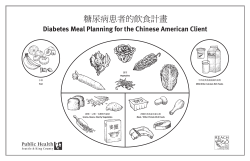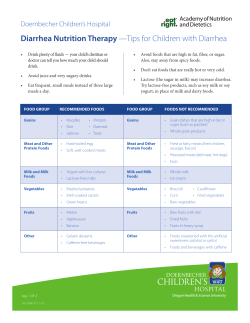
EAT SMART 3 COOL TOOLS AND A SMOOTHIE
PRESENT … EAT SMART 3 COOL TOOLS AND A SMOOTHIE Learning to cook is a great way to take charge of your own health: when you cook meals from scratch, you’ll know exactly what’s in them—all the wholesome ingredients you choose to include! Plus, cooking at home is fun, educational, and less expensive than eating out or buying prepared and processed foods. Learn to cook, and you’ll have fun, take pride in your creations, and know that you’re helping your family live better. Berry BoLd Banana Smoothie A smoothie is a great recipe to start with. It’s easy, but it can teach you so much about what flavors you like and how to achieve them. Plus, it’s a great example of a homemade food that’s healthy—when the packaged versions can be so unhealthy (see the sections that follow). ❚ ADULT: YES ❚ HANDS-ON TIME: 10 MINUTES ❚ TOTAL TIME: 10 MINUTES ❚ MAKES: 2 SERVINGS KITCHEN GEAR Measuring cup Blender (adult needed) 2 drinking glasses INSTRUCTIONS Wash your hands with soap and water, then gather all your equipment and ingredients and put them on a clean counter. INGREDIENTS ¼ cup water, orange juice, or low-fat milk ½ cup plain low-fat yogurt ¼ cup fresh or frozen (unsweetened) raspberries ¼ cup fresh or frozen strawberries or blueberries ½ overripe banana, peeled and sliced 2 ice cubes 1. Put all the ingredients in the blender in the order listed. 2. Put the top on tightly. Turn the blender to a medium setting and blend until the ice is chopped and the mixture is smooth, about 1 minute. 3. Serve right away—or store in a thermos or covered in the refrigerator, up to 4 hours. INSIDE: Let’s compare ingredients • How to read a nutrition label • How to think about food ads Try this! If you can look at a food and imagine it growing in a natural environment that’s a good sign it’s a healthy option. Imagine a plum growing on a tree. Now imagine a puffed cheese snack growing on a tree. Cheese Puffs Don’T Grow on Trees How to Read a Nutrition Label Food is the fuel that keeps your body running smoothly. Ideally, the food you eat provides great energy (calories), protein, dietary fiber, healthy fats, vitamins, and minerals— without bringing along too much sugar or salt, unhealthy fats, or unsafe food additives. Packaged foods are required to have a Nutrition Facts label, which should help you figure out how nutritious a food is. Let’s look at our yogurt again. Serving sizes are standardized portions that allow you to compare the nutrient amounts in similar foods. Nutrition Facts Serving Size 3/4 cup (6 fl oz) Amount Per Serving Calories 135 Many of the healthiest foods don’t need ingredient lists on them! That’s because they are “whole foods”— foods that are naturally how they are and haven’t had anything added to or taken out of them. Fruits and vegetables, nuts, eggs, fish, and whole grains such as oats and brown rice are all examples of whole foods. Most plain dairy products are wholesome too, even though milk might have added vitamins, and yogurt is milk with good bacteria added to it. Processed food — the kind that usually comes in bags, cans, jars, boxes, and other containers—is required by the government to have a label listing its ingredients. This list tells you what the food is made of. The ingredients are listed in order of most to least. Look for whole-foods ingredients at the start of the list. If you see white flour, sugar, or highfructose corn syrup high up there, that’s a red flag. What about those chemical names that you don’t recognize? Artificial colors and flavors, artificial sweeteners, and preservatives are there to make foods look brighter, to add flavor (for example, to make something taste like cherries without adding any real cherries), or to make food last on the shelf for a long time. Some of these ingredients are controversial, which means that people disagree about whether they are safe to eat. Compare the ingredient list of a popular brand of plain low-fat yogurt: Cultured low-fat milk. Contains active yogurt cultures including L. acidophilus. …with the ingredient list of a popular brand of “kids’” yogurt: What do you notice? Total Fat 1.5g Saturated Fat 0.5g Trans Fat 0g “Cultures” are special safe bacteria that make the milk thick and tart. • What are each of those ingredients doing in that second list? (Look up any words you don’t recognize.) • The plain yogurt might not be appealing to you to eat. What do you think would be a better way to make the yogurt taste and look good without adding sugar or other food additives? • How does the ingredient list from our smoothie recipe compare? Sugar is fine when it occurs naturally (such as in fresh fruit), but eating too much added sugar or corn syrup is not healthy. Avoid processed foods that have more than 8 grams (two teaspoons) of sugar per serving, unless you are eating dessert. % Daily Values* 1% 1% Cholesterol 5mg Sodium 190mg Potassium 625mg Total Carbohydrate 19g Dietary Fiber 0g Sugars 19g Protein 14g Vitamin A 0% Calcium 50% Let’s Compare Ingredients Cultured Low Fat Milk, Sugar, Modified Corn Starch, Kosher Gelatin, Tricalcium Phosphate, Citric Acid, Natural and Artificial Flavor, Potassium Sorbate Added to Maintain Freshness, Carrageenan, Yellow #5, Blue #1, Vitamin A Acetate, Vitamin D3. Fats are tricky. Some, like olive oil, or the kinds in nuts or fish, are good for you, while others are not. “Saturated Fat” is less healthy, and “Trans Fat” is the worst. The words “partially hydrogenated” in the ingredients list lets you know that trans fat is in there. Calories from Fat 5 2% 8% 6% 0% Vitamin C 5% Iron 1% * Percent Daily Values are based on a 2000 calorie diet. Your daily values may be higher or lower depending on your calorie needs. You decide! Calories tell you how much energy is contained in a serving of food. The calories themselves aren’t bad or good; what’s most important is whether they come from nutrientdense ingredients. Sodium comes mostly from salt. Many processed foods have more salt than is healthy, as too much sodium can raise blood pressure. Dietary fiber is good for you and keeps your digestion healthy. Fruits, vegetables, beans, and whole grains tend to have lots of it. Protein is your body’s basic building block. Foods with a lot of protein give you energy for a long time. Vitamins and minerals are some of the most valuable parts of foods. The more the merrier—but don’t be fooled by products that advertise added vitamins, minerals, and fiber, but are high in sugar. What do you think about the yogurt? Is it bad for you? Good for you? Both? Neither? Stop. Look. Listen. Think. Companies advertise their processed foods on TV, online, and in magazines to encourage people to buy them. They want to sell them because that’s how they make money. It’s that simple. And they think of kids as an easy target. They think that if they make their smoothies supersweet, or include a prize in their cereal box, or put a cute cartoon character on the package, or make the kids in their commercial seem cool, you’ll want to buy it (or pester your parents to buy it). But is it good for you? Educate yourself. Learn the basics of nutrition and shop for your health — not because of how something is packaged or advertised. Be skeptical. Don’t believe everything you hear or see! Just because a food is being marketed to kids doesn’t mean it’s good for kids. Figure out if it is or isn’t. Discuss with your parents or teacher. Invest wisely. Every dollar you spend is an investment in the company that makes the food. It’s like voting — it all adds up, and every dollar counts. Spend your (or your parents’) money on food that’s good for you, not on food that is slickly advertised. Take Action with Food Day! October 24, 2013 Celebrate healthy, delicious food and the people who grow, harvest, and serve it. Everyone can learn how to grow food, cook together, and make good choices about what they eat. Introduce cooking lessons at your school, talk to your friends about healthy eating, try new fruits and vegetables, or teach someone to cook a new recipe. The possibilities are endless! www.foodday.org Food for Thought What different methods are advertisers using to grab your attention? Are the ads aimed at kids different from those aimed at adults? Why don’t you see TV commercials for fresh fruits or vegetables? For home cooking? Have you ever bought—or wanted to buy—a product because of the way it was advertised? To subscribe to THE FUN COOKING MAGAZINE FOR FAMILIES go to www.chopchopmag.org
© Copyright 2025





















